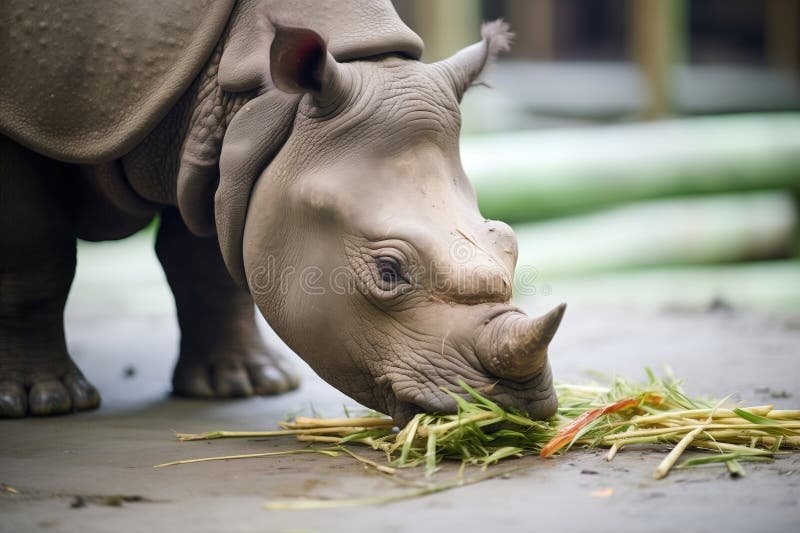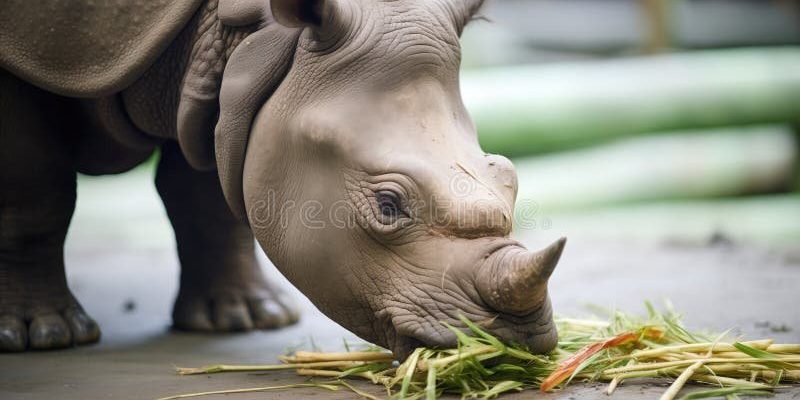
You might be wondering where they fit into the food chain. Unlike predators that hunt for their meals, Javan rhinos are herbivores. They’re more like nature’s gardeners, shaping their environment while they graze on a rich diet of leaves, fruits, and other vegetation. Their lifestyle reveals a lot about the ecosystems they inhabit and the conservation challenges they face. Let’s dive deeper into what these incredible animals eat, how they find their food, and why it all matters for their survival.
Diet Overview of the Javan Rhinoceros
The diet of the Javan rhinoceros mainly consists of a variety of plants. They are leaf-loving animals, often found munching on:
- Grass
- Fruits
- Leaves
- Ferns
- Bark
Rhinos have a particular preference for the fibrous, nutritious parts of plants, which help them maintain their weight and health. They use their specialized lips to grasp and strip leaves and branches, making them quite adept at foraging in their forested habitats.
You might think that being a herbivore means these rhinos have an easy life. But here’s the thing: their diet isn’t just about eating whatever they come across. They have to choose foods that provide enough nutrients, especially since their bulky size requires a lot of energy. This means they often gravitate toward younger, tender leaves or fruits that are richer in vitamins and minerals.
Feeding Habits and Patterns
Javan rhinos are mostly solitary feeders. This means they typically search for food alone rather than in groups. They venture out during cooler hours of the day, like early mornings or late afternoons, to forage for food. Why cooler times? Well, just like us, rhinos can get overheated, and foraging when it’s cooler helps them conserve energy.
They also tend to graze on the same plants repeatedly, which can sometimes lead to overgrazing. This might seem harmless, but it can disrupt their habitat and affect other species that depend on the same plants. It’s a tightrope act that shows how interconnected nature really is.
Interestingly, they also create pathways through the dense vegetation as they move around. These paths aren’t just helpful for them; they also benefit other animals in their ecosystem. When rhinos create new paths, it allows for easier movement for various species, promoting biodiversity in their environment.
Hunting for Food: A Misnomer
You might think of “hunting strategies” as a way to describe how an animal chases down its prey. But for the Javan rhinoceros, that term doesn’t quite apply. These magnificent creatures are herbivores, meaning they don’t hunt other animals. Instead, their “hunting” involves foraging and searching for the best plant life.
In their forest homes, they use their keen sense of smell to locate the freshest and most nutritious plants. This is where their survival instincts come into play. They’re not just wandering aimlessly; they’re carefully selecting their meals for maximum health benefits. It’s a different kind of strategy—one that’s all about being smart rather than swift.
To make it even clearer, consider how a gardener picks the best fruits and veggies. They don’t just grab whatever is nearby; they choose the ripest and healthiest options. That’s how Javan rhinos select their food, ensuring they get what they need to thrive while avoiding less nutritious options.
Seasonal Changes and Their Impact
The Javan rhinoceros’ diet can shift with the seasons. During wetter months, when plants are more abundant, they have a varied and rich diet. They tend to consume a wider range of plant species, which helps them stay healthy and strong. However, during the dry season, food scarcity can become an issue. With less vegetation available, they might struggle to find their preferred meals.
This seasonal variability in diet is crucial because it impacts their overall health. If they don’t get enough nutrients during these dry months, it can lead to health problems. For this reason, conservationists are really focused on protecting the areas where Javan rhinos live. Ensuring that these habitats are preserved means that rhinos will have access to the diverse food sources they need throughout the year.
Moreover, during these challenging times, they might adapt by changing their foraging habits. Discovery of new food sources can be a game changer, showing how resourceful these creatures can be under pressure.
The Importance of Conservation
The Javan rhinoceros is critically endangered, with fewer than 80 individuals remaining in the wild. Their dwindling numbers are primarily due to habitat loss and poaching. Protecting their diet and foraging grounds is key to their survival. When we think about conservation, it’s not just about saving the rhinos themselves, but also about preserving the delicate ecosystems they inhabit.
Conservation efforts focus on creating protected areas where Javan rhinos can safely roam and find food. This involves not only safeguarding their immediate habitats but also ensuring that the surrounding areas are healthy and sustainable. These efforts can include:
- Establishing national parks
- Restoring native vegetation
- Educating local communities about the importance of rhinos
By protecting these amazing creatures, we also protect the balance of the ecosystem they live in. It’s a big job, but every little effort counts.
The Role of the Javan Rhinoceros in Their Ecosystem
The Javan rhinoceros acts like a natural gardener, shaping their environment as they forage for food. But why does this matter? Well, when they graze and munch on plants, they help control the growth of certain vegetation. This prevents any one plant species from overtaking an area and allows for a rich mix of plant life, which benefits many other animals.
Additionally, as they walk through the forests, they create trails that other animals can use. This contribution to their ecosystem highlights how interconnected wildlife can be. Healthy rhino populations often lead to healthier habitats, which, in turn, support other species.
So, the next time you think about the Javan rhinoceros, remember that these magnificent creatures do much more than just eat. They play an essential role in maintaining the balance of their ecosystem, benefitting countless other species along the way.
The diet and hunting strategies of the Javan rhinoceros showcase the beauty and complexity of nature. While they may not hunt in the traditional sense, their foraging habits and choices reflect a fascinating survival strategy. As we learn more about their diets, we also uncover the critical importance of preserving their habitats and ensuring their survival.
Ultimately, the survival of the Javan rhinoceros is a reflection of our commitment to protecting the environment. By understanding their dietary needs and natural behaviors, we can better advocate for their conservation. Together, we can help ensure that future generations get to admire and learn from these incredible creatures, keeping their legacy alive in the heart of Indonesia’s forests.

